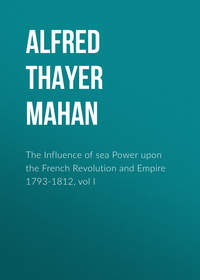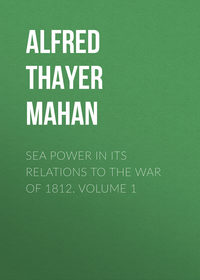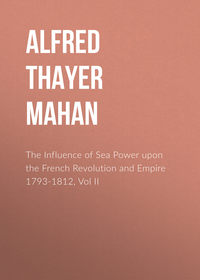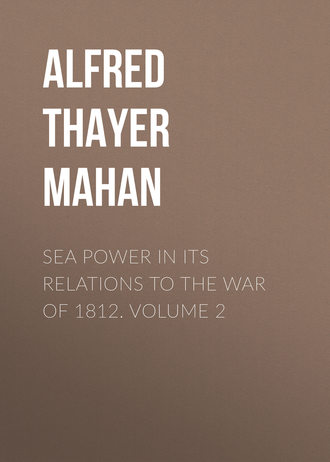 полная версия
полная версияSea Power in its Relations to the War of 1812. Volume 2
Dearborn, who still remained in chief command of the armies on the New York frontier, was therefore directed to concentrate his effort upon Ontario, starting from Sackett's Harbor as a base. Chauncey, whose charge extended no farther than the upper rapids of the St. Lawrence, had of course no other interest. His first plan, transmitted to the Navy Department January 21, 1813,41 had been to proceed immediately upon the opening of navigation, with the fleet and a land force of a thousand picked troops, against Kingston, the capture of which, if effected, would solve at a single stroke every difficulty in the upper territory. No other harbor was tenable as a naval station; with its fall, and the destruction of shipping and forts, would go the control of the lake, even if the place itself were not permanently held. Deprived thus of the water communications, the enemy could retain no position to the westward, because neither re-enforcements nor supplies could reach them. To quote Chauncey's own words, "I have no doubt we should succeed in taking or destroying their ships and forts, and, of course, preserve our ascendency on this lake."
This remark, though sound, was narrow in scope; for it failed to recognize, what was perfectly knowable, that the British support of the Lake Erie stations and the upper country depended on their power to control, or at worst to contest, Ontario. Of this they themselves were conscious, as the words of Yeo and Brock alike testify. The new American Secretary of War, Armstrong, who was a man of correct strategical judgment and considerable military information, entered heartily into this view; and in a letter dated February 10 communicated to Dearborn the orders of the President for his operations, based upon the Secretary's recommendation.42 Four thousand men were to be assembled at Sackett's, and three thousand at Buffalo. The former, under convoy of the fleet, was to proceed first against Kingston, then against York (Toronto). After this the two corps should co-operate in an attack to be made upon the British Niagara frontier, which rested upon Fort George on the Ontario shore, and Fort Erie upon Lake Erie. This plan was adopted upon the assumption, which was probably correct, that the enemy's entire military force upon Ontario did not exceed twenty-one hundred regular troops, of whom six hundred were at Kingston and twelve hundred at Niagara. Armstrong, who recognized the paramount importance of Montreal, had received the exaggerated impression that there might be in that neighborhood eight to ten thousand regulars. There were not yet nearly that number in all Canada;43 but he was perhaps correct in thinking that the provision for the offensive, which he had found upon taking office a few weeks before, was insufficient for an advance in that quarter.
Dearborn very soon discovered objections to proceeding against Kingston, in his own estimates of the enemy's numbers, based upon remarkable reports received from sources "entitled to full credit." On March 3 he was satisfied that from six to eight thousand men had been assembled there from Quebec, Montreal, and Upper Canada; while the presence of Sir George Prevost, the Governor General, and commander-in-chief in Canada, who had seized an opportunity to make a hurried visit to Kingston to assure himself as to the progress of the ships building, convinced the American general that an attack upon Sackett's was contemplated.44 From that time forward Dearborn realized in his own person the process of making pictures to one's self concerning a military situation, against which Napoleon uttered a warning. Chauncey was more sceptical, although he could not very well avoid attention to the reports brought in. He expresses himself as believing that a considerable number of men had been assembled in Kingston, but that their real object was to proceed against Harrison in the Far West.45
There seems to have been no foundation for any of these alarms. Prevost was a soldier of good reputation, but wanting in initiative, audacity, and resolution, as the current war was to prove. His presence at Kingston at this moment was simply one incident in a rapid official visit to the upper military posts, extending as far as Niagara, and accomplished in four weeks; for, leaving Quebec February 17, he was again writing from there on the 17th of March. As far as can be deduced from his correspondence, four companies of regulars had preceded him from Montreal to Kingston, and there may very well have been a gathering of local forces for inspection or otherwise; but no re-enforcements of regulars, other than that just mentioned, reached Kingston from down the river before May. Dearborn never renounced his belief in the meditated attack, though finally satisfied that it was abandoned; and his positive reports as to the enemy's numbers wrung from Armstrong acquiescence in a change of plan, by which York, and not Kingston, should be the first object of the campaign.46
Chauncey, who had some sound military ideas, as his first plan showed, was also brought round to this conclusion by a process of reasoning which he developed in a second plan of operations, submitted March 18,47 but evidently long since matured. It apparently antedates Dearborn's apprehensions, and is not affected by them, though the two worked together to a common mistaken decision. The commodore's letter presents an interesting study, in its demonstration of how an erroneous first conception works out to false conclusions, and in the particular instance to ultimate military disaster. The capture of Kingston, his first plan, and its retention, which Armstrong purposed, would have settled the whole campaign and affected decisively the issue of the war. Chauncey's new project is dominated throughout by the view, which was that of the Government, that the great object of the war was to control the northwestern territory by local operations, instead of striking at the source of British power in its communication with the sea. At this moment, the end of March, the British naval force on Ontario was divided between York and Kingston; in each were vessels afloat and vessels building. An attack upon Kingston, Chauncey said, no doubt would be finally successful—an initial admission which gave away his case; but as the opposing force would be considerable, it would protract the general operations of the campaign—the reduction of the northwest—longer than would be advisable, particularly as large re-enforcements would probably arrive at Quebec in the course of two months. On the other hand, to proceed against York, which probably could be carried immediately, would result in destroying at once a large fraction of the British fleet, greatly weakening the whole body. Thence the combined Americans would turn against Fort George and the Niagara line. If successful here, the abandonment of Fort Erie by the British would release the American vessels which by its guns were confined at Black Rock. They would sail forth and join their consorts at Erie; which done, Chauncey, leaving his Ontario fleet to blockade Yeo at Kingston, would go to the upper lake and carry against the British the squadron thus concentrated there, would co-operate with the army under General Harrison, recover Detroit, and capture Malden. Lake Erie and its surroundings would thus become an American holding. After this, it would be but a step to reconquer Michilimackinac, thereby acquiring an influence over the Indians which, in conjunction with military and naval preponderance, would compel the enemy to forsake the upper country altogether, and concentrate his forces about Kingston and Montreal.
It is interesting to see an elaborate piece of serious reasoning gradually culminate in a reductio ad absurdum; and Chauncey's reasoning ends in a military absurdity. The importance of Kingston is conceded by him, and the probability of capturing it at the first is admitted. Thereupon follows a long project of operation, which ends in compelling the enemy to concentrate all his strength at the very points—Kingston and Montreal—which it is most important for the Americans to gain; away from which, therefore, they should seek to keep the enemy, and not to drive him in upon them. This comes from the bias of the Government, and of the particular officer, regarding the Northwestern territory as the means whereby success was to be accomplished instead of merely the end to be attained. To make the Western territory and control of the Indians the objects of the campaign was a political and military motive perfectly allowable, and probably, in view of recent history, extremely necessary; but to make these things the objective of operations was to invert the order of proceedings, as one who, desiring to fell a tree, should procure a ladder and begin cutting off the outermost branches, instead of striking at the trunk by the ground.
Eighteen months later Chauncey wrote some very wise words in this spirit. "It has always been my opinion that the best means to conquer Canada was to cut off supplies from Lower to Upper by taking and maintaining some position on the St. Lawrence. That would be killing the tree by girdling; the branches, dependent on ordinary supplies, die of necessity. But it is now attempted to kill the tree by lopping off branches" [he is speaking of the Niagara campaign of 1814]; "the body becomes invigorated by reducing the demands on its resources."48 By this time Chauncey had been chastened by experience. He had seen his anticipated glory reaped on Lake Erie by his junior. He had seen the control of Ontario contested, and finally wrung from him, by vessels built at Kingston, the place which he had failed to take when he thought it possible. He had been blockaded during critical months by a superior squadron; and at the moment of writing, November 5, 1814, Sir James Yeo was moving, irresistible, back and forth over the waters of Ontario, with his flag flying in a ship of 102 guns, built at Kingston. In short, the Canadian tree was rooted in the ocean, where it was nourished by the sea power of Great Britain. To destroy it, failing the ocean navy which the United States had not, the trunk must be severed; the nearer the root the better.
Demonstration of these truths was not long in coming, and will be supplied by the narrative of events. When Chauncey penned the plan of operations just analyzed, there were in York two vessels, the "Prince Regent" of twenty guns, the "Duke of Gloucester," sixteen, and two—by his information—on the stocks. On April 14 the ice in Sackett's Harbor broke up, though large floes still remained in the lake. On the 19th these also had disappeared. Eighteen hundred troops were embarked by the squadron, and on the 24th the expedition started, but was driven back by heavy weather. The next day it got away finally, and on the early morning of the 27th appeared off York. The troops were landed westward of the town, and proceeded to attack, supported by the shipping. The enemy, inferior in number, retired; the small regular force making its escape, with the exception of fifty who surrendered with the militia present. The American loss, army and navy, was a little over three hundred; among whom was General Pike, an excellent soldier, who commanded the landing and was mortally wounded by the explosion of a magazine. The "Duke of Gloucester" schooner was taken, but the "Prince Regent" had gone to Kingston three days before; the weather which drove Chauncey back had enabled her to join her fleet as soon as released by the ice. By her escape the blow lost most of its effect; for York itself was indefensible, and was taken again without difficulty in the following July. A 30-gun vessel approaching completion was found on the stocks and burned, and a large quantity of military and naval stores were either destroyed or brought away by the victorious squadron. These losses were among the news that greeted Yeo's arrival; but, though severe, they were not irreparable, as Chauncey for the moment imagined. He wrote: "I believe that the enemy has received a blow that he cannot recover, and if we succeed in our next enterprise, which I see no reason to doubt, we may consider the upper province as conquered."49 The mistake here was soon to be evident.
No time was wasted at York. The work of destruction, and of loading what was to be carried away, was completed in three days, and on May 1 the troops were re-embarked, to sail for Fort George on the morrow. The wind, which for some days had been fair and moderate from the eastward, then came on to blow a gale which would make landing impossible off Niagara, and even navigation dangerous for the small vessels. This lasted through the 7th, Chauncey writing on that day that they were still riding with two anchors ahead and lower yards down. So crowded were the ships that only half the soldiers could be below at one time; hence they were exposed to the rain, and also to the fresh-water waves, which made a clean breach over the schooners. Under such circumstances both troops and seamen sickened fast. On the 8th, the weather moderating, the squadron stood over to Fort Niagara, landed the troops for refreshment, and then returned to Sackett's; it being thought that the opportunity for surprise had been lost, and that no harm could come of a short further delay, during which also re-enforcements might be expected.
Soon after his return Chauncey sent a flag of truce to Kingston. This made observations as to the condition of the enemy which began to dispel his fair illusions.50 His purpose to go in person to Niagara was postponed; and despatching thither the squadron with troops, he remained at Sackett's to protect the yard and the ships building, in co-operation with the garrison. His solicitude was not misplaced. Niagara being a hundred and fifty miles from Sackett's, the fleet and army had been committed to a relatively distant operation, depending upon a main line of communication,—the lake,—on the flank and rear of which, and close to their own inadequately protected base, was a hostile arsenal, Kingston, harboring a naval force quite able to compete with their own. The danger of such a situation is obvious to any military man, and even to a layman needs only to be indicated. Nevertheless the enterprise was launched, and there was nothing for it now but to proceed on the lines laid down.
Chauncey accordingly sailed May 22, re-enforcements of troops for the defence of Sackett's having meantime arrived. He did not reach Niagara until the 25th. The next day was spent in reconnoissances, and other preparations for a landing on the lake shore, a short mile west of Fort George. On the 27th, at 9 A.M., the attack began, covered by the squadron. General Vincent, in command of the British Niagara frontier, moved out to meet his enemy with the entire force near Fort George, leaving only a small garrison of one hundred and thirty men to hold the post itself. There was sharp fighting at the coast-line; but Vincent's numbers were much inferior, and he was compelled steadily to give ground, until finally, seeing that the only alternatives were the destruction of his force or the abandonment of the position, he sent word to the garrison to spike the guns, destroy the ammunition, and to join his column as it withdrew. He retreated along the Niagara River toward Queenston, and thence west to Beaver Dam, about sixteen miles from Fort George. At the same time word was sent to the officers commanding at Fort Erie, and the intermediate post of Chippewa, to retire upon the same place, which had already been prepared in anticipation of such an emergency. The three divisions were thus in simultaneous movement, converging upon a common point of concentration, where they all assembled during the night; the whole, as reported by Vincent to his superior, now not exceeding sixteen hundred.51 The casualties during the day's fighting had been heavy, over four hundred killed and wounded; but in the retreat no prisoners were lost except the garrison of the fort, which was intercepted. Dearborn, as before at York, had not landed with his troops; prevented, doubtless, by the infirmities of age increasing upon him. Two days later he wrote to the Department, "I had presumed that the enemy would confide in the strength of his position and venture an action, by which an opportunity would be afforded to cut off his retreat."52 This guileless expectation, that the net may be spread not in vain before the eyes of any bird, provoked beyond control such measure of equanimity as Armstrong possessed. Probably suspecting already that his correct design upon Kingston had been thwarted by false information, he retorted: "I cannot disguise from you the surprise occasioned by the two escapes of a beaten enemy; first on May 27, and again on June 1. Battles are not gained, when an inferior and broken enemy is not destroyed. Nothing is done, while anything that might have been done is omitted."53 Vincent was unkind enough to disappoint his opponent. The morning after the engagement he retired toward a position at the head of the lake, known then as Burlington Heights, where the town of Hamilton now stands. Upon his tenure here the course of operations turned twice in the course of the next six months.
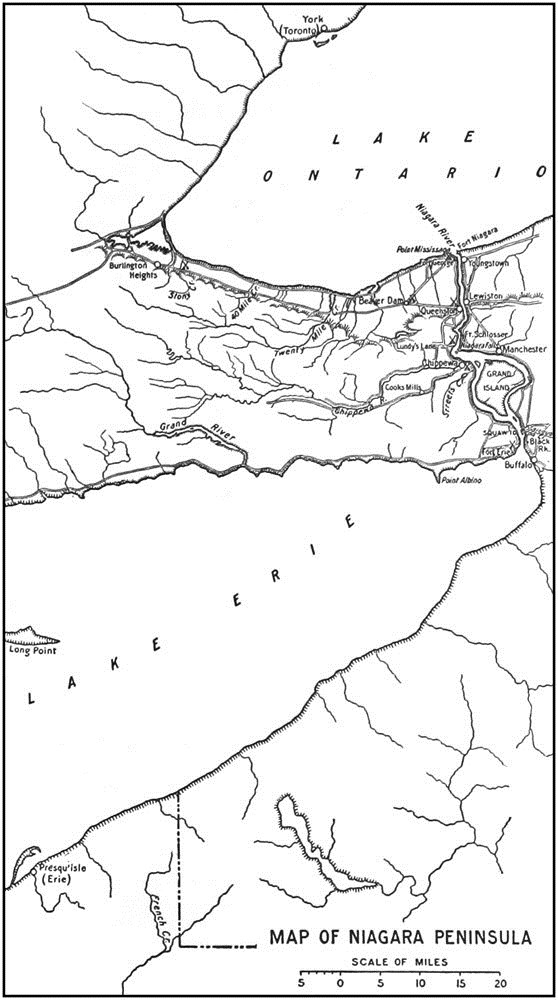
MAP OF NIAGARA PENINSULA
While Vincent was in retreat upon Burlington, Captain Barclay arrived at his headquarters, on the way to take charge of the Lake Erie squadron;54 having had to coast the north shore of Ontario, on account of the American control of the water. The inopportuneness of the moment was prophetic of the numberless disappointments with which the naval officer would have to contend during the brief three months preceding his defeat by Perry. "The ordnance, ammunition, and other stores for the service on Lake Erie," wrote Prevost on July 20, with reference to Barclay's deficiencies, "had been deposited at York for the purpose of being transported to Amherstburg, but unfortunately were either destroyed or fell into the enemy's hands when York was taken by them; and the subsequent interruption to the communication, by their occupation of Fort George, has rendered it extremely difficult to afford the supplies Captain Barclay requires, which, however, are in readiness to forward whenever circumstances will permit it to be done with safety."55 The road from Queenston to Fort Erie, around Niagara Falls, was the most used and the best line of transportation, because the shortest. To be thrown off it to that from Burlington to Long Point was a serious mishap for a force requiring much of heavy and bulky supplies. To add to these more vital embarrassments, the principal ship, the "Queen Charlotte," which had been lying at Fort Erie, had been ordered by Vincent to leave there when the place was evacuated, and to go to Amherstburg, thus giving Barclay the prospect of a land journey of two hundred miles through the wilderness to his destination. Fortunately for him, a vessel turned up at Long Point, enabling him to reach Amherstburg about June 7.
The second step in Chauncey's programme had now been successfully taken, and the vessels at Black Rock were free to move. With an energy and foresight which in administration seldom forsook him, he had prepared beforehand to seize even a fleeting opportunity to get them out. Immediately upon the fall of York, "to put nothing to hazard, I directed Mr. Eckford to take thirty carpenters to Black Rock, where he has gone to put the vessels lying there in a perfect state of repair, ready to leave the river for Presqu' Isle the moment we are in possession of the opposite shore." Perry also was on hand, being actively engaged in the landing at Fort George; and the same evening, May 27, he left for Black Rock to hasten the departure. The process involved great physical labor, the several vessels having to be dragged by oxen against the current of the Niagara, here setting heavily toward the falls. It was not until June 12 that they were all above the rapids, and even this could not have been accomplished but for soldiers furnished by Dearborn.56 The circumstance shows how hopeless the undertaking would have been if the enemy had remained in Fort Erie. Nor was this the only peril in their path. Barclay, with commendable promptitude, had taken the lake in superior force very shortly after his arrival at Amherstburg, and about June 15 appeared off Erie [Presqu' Isle]. Having reconnoitred the place, he cruised between it and Black Rock, to intercept the expected division; but the small vessels, coasting the beach, passed their adversary unseen in a fog,57 and on June 18 reached the port. As Chauncey had reported on May 29 that the two brigs building there were launched, affairs on that lake began to wear a promising aspect. The Lakes station as a whole, however, was still very short of men; and the commodore added that if none arrived before his approaching return to Sackett's, he would have to lay up the Ontario fleet to man that upon Erie.
To do this would have been to abandon to the enemy the very important link in the communications, upon which chiefly depended the re-enforcement and supplies for both armies on the Niagara peninsula. The inherent viciousness of the plan upon which the American operations were proceeding was now quickly evident. At the very moment of the attack upon Fort George, a threatening but irresolute movement against Sackett's was undertaken by Prevost, with the co-operation of Yeo, by whom the attempt is described as a diversion, in consequence of the enemy's attack upon Fort George. Had the place fallen, Chauncey would have lost the ship then building, on which he was counting to control the water; he would have had nowhere to rest his foot except his own quarter-deck, and no means to repair his fleet or build the new vessels continually needed to maintain superiority. The case of Yeo dispossessed of Kingston would have been similar, but worse; for land transport in the United States was much better than in Canada. The issue of the war, as regarded the lakes and the Northwestern territory, lay in those two places. Upon them depended offensive and defensive action.
At the time of the attack upon Sackett's only two vessels of the squadron were there, the senior officer of which, Lieutenant Chauncey, was in momentary command of the navy yard as well. The garrison consisted of four hundred regular troops, the coming of whom a week before had enabled Chauncey to leave for Niagara. Dearborn had already written to Major-General Jacob Brown, of the New York militia, asking him to take command of the station; for which his local knowledge particularly fitted him, as he was a resident of some years' standing. He had moreover manifested marked military capacity on the St. Lawrence line, which was under his charge. Brown, whose instincts were soldierly, was reluctant to supersede Colonel Backus, the officer of regulars in command; but a letter from the latter received on the 27th, asking him to take charge, determined his compliance. When he arrived five hundred militia had assembled.
The British expedition left Kingston with a fine fair wind on the early morning of May 27—the same day that the Americans were landing at Fort George. The whole fleet accompanied the movement, having embarked troops numbering over seven hundred; chiefly regulars. At noon they were off Sackett's Harbor. Prevost and Yeo stood in to reconnoitre; but in the course of an hour the troops, who were already in the boats, ready to pull to the beach, were ordered to re-embark, and the squadron stood out into the lake. The only result so far was the capture of twelve out of nineteen American barges, on their way from Oswego to the Harbor. The other seven gained the port.
During the next thirty-six hours militia kept coming in, and Brown took command. Sackett's Harbor is an indentation on the south side of a broad bay, called Black River Bay, into which the Black River empties. The harbor opens eastward; that is, its back is toward the lake, from which it is distant a little over a mile; and its north side is formed by a long narrow point, called Navy Point, on which was the naval establishment. Where Black River Bay meets the lake, its south shore is prolonged to the west by a projection called Horse Island, connected with the land by a fordable neck. Brown expected the landing to be made upon this, and he decided to meet the attack at the water's edge of the mainland, as the enemy crossed the neck. There he disposed his five hundred militia, placing the regulars under Backus in a second line; a steadying point in case the first line of untrained men failed to stand firm. It was arranged that, if the enemy could not be resisted, Lieutenant Chauncey was to set fire to the naval stores and shipping, and cross with his crews to the south side of the harbor, east of a work called Fort Volunteer, where Brown proposed to make his final stand. From there, although an enemy at the yard could be molested, he could not certainly be prevented from carrying off stores or ships; hence the necessity for destruction.







